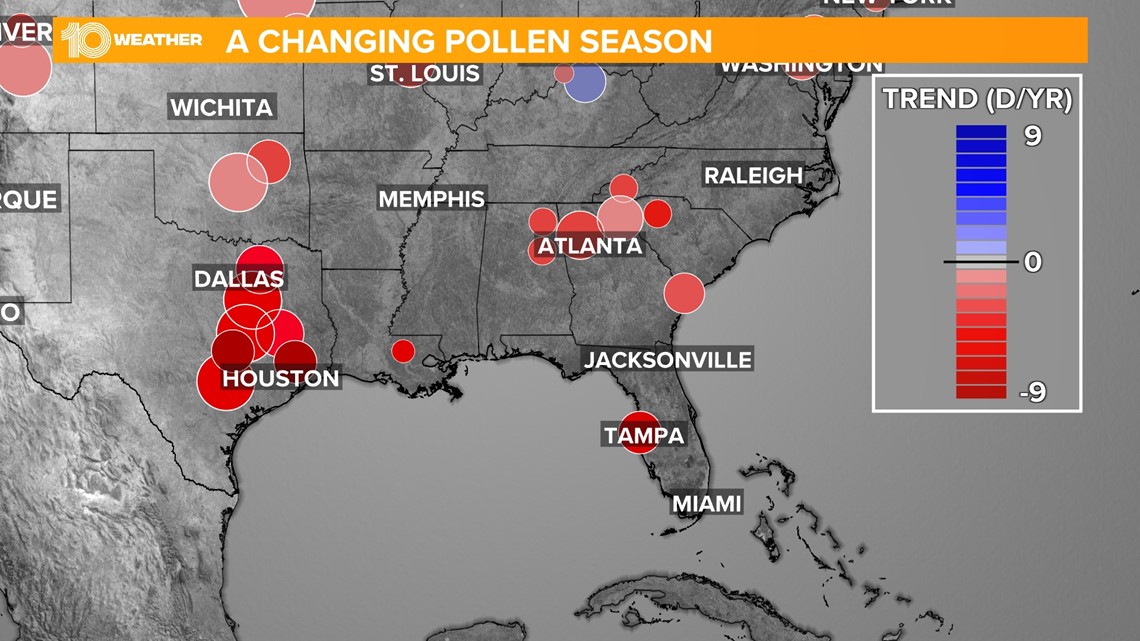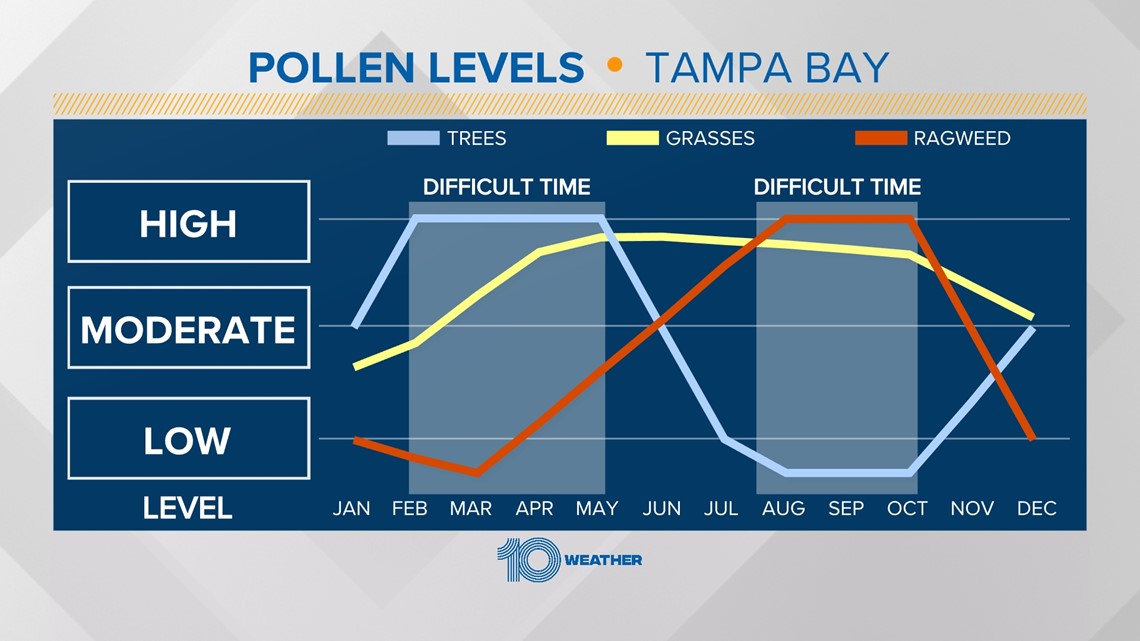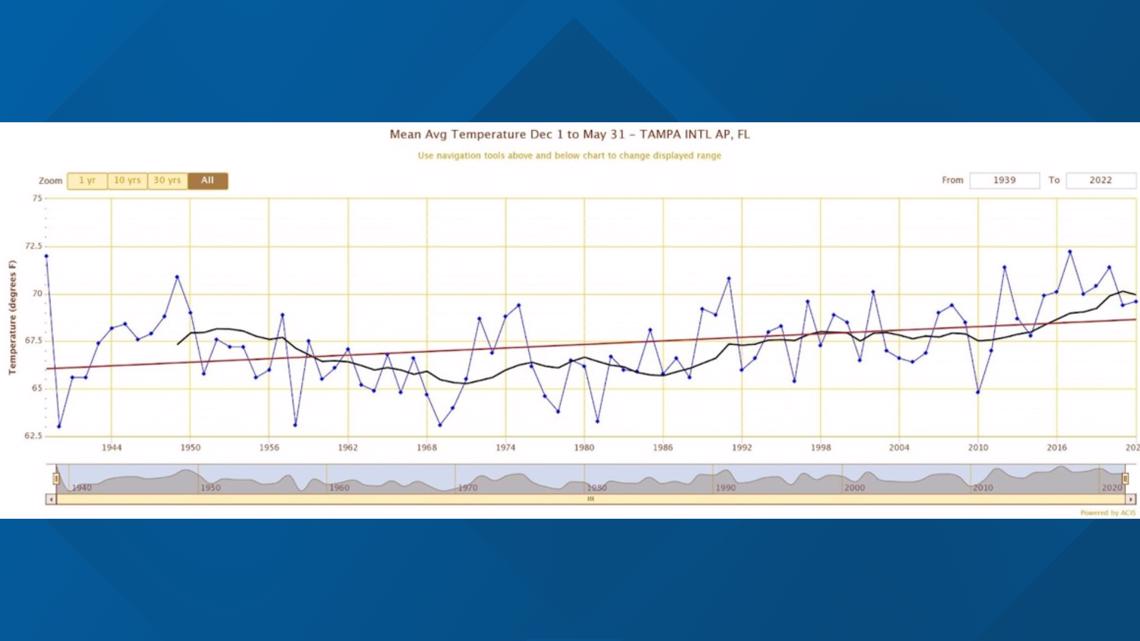ST. PETERSBURG, Fla. — Even in Florida, the cooler months of the year are followed by warmer and more pleasant conditions as we enter spring.
The warmer temperatures and increased sunshine of springtime or late winter are the cues to plants and trees to begin their annual pollen season. Our allergies and the symptoms that follow are simply collateral damage of plants releasing tiny pollen grains to fertilize other trees and plants of the same species.
Warming temperatures and increased carbon dioxide as a result of human-caused climate change are causing pollen season to start earlier, last longer and become more intense. As a result, this is directly impacting our health.
Kenneth Mendez, the president and CEO of the Asthma and Allergy Foundation of America says, "There's a real link between climate change and health and people are starting to feel it now."
Increased carbon dioxide and warming temperatures are the underlying drivers of our changing climate, and now we are realizing the impact that has on pollen and your allergies.
Mendez says that with climate change and the warmer temperatures, the growing seasons have gotten longer. As a result, if you suffer from seasonal allergies you’ll be feeling it much sooner. Not only are warmer temperatures causing an early release of pollen, but increased levels of carbon dioxide in the atmosphere are driving plants to release more pollen in general.
A study published in the proceedings of the National Academy of Sciences in 2021 showed that in the 60 pollen reporting stations across the United States, the pollen season had become 20 days longer compared to what it was in 1990. And human-caused climate change was responsible for at least half of the additional days of pollen season. The study’s conclusion, "Climate-driven pollen trends are likely to further exacerbate respiratory health impacts in coming decades.”


A reporting station in Tampa was one of the sites monitored and not only did it show a strong signal for a longer pollen season, but more pollen in general, directly impacting your allergies.
While this may be minor discomfort for some, allergies can be a trigger for those with asthma and result in a much more serious reaction. Close to 3,000 people die each year as a result of asthma. So, while the impacts of climate change on pollen and our allergies impacts all of us differently, this trend of longer and more intense pollen seasons is increasingly concerning for those with more severe allergies and asthma.
More than just warmth and CO2
As our atmosphere warms, researchers are finding that as a result of a combination between more heat and more moisture evaporating into the atmosphere, storms are becoming more intense. This increases the risk to our lives and our property, but it also has an impact on allergies.
"There’s something called thunderstorm, lightning allergy," says Mendez, " where you get the heavy winds going with these intense storms and it whips up a lot of the pollen and dust so that could be a trigger."
Research has shown that these more intense storms expected with climate change will further expand the reach of pollen, but the strong winds and heavier precipitation associated with severe thunderstorms can also cause pollen grains to burst, releasing even more and much smaller allergen particles into the air.
Mendez went on to say, "We’re actually feeling we are the canaries in the coal mine because as you get more severe allergies that’s a direct result of this climate change. These are more intense releases of pollen. So, we’re feeling it and there’s a direct link to your health."
Pollen in Tampa Bay
A three-year aerobiologic pollen survey (1979-1981) was conducted in Tampa Bay to understand the primary drivers and timeline for our pollen and allergy season.
The survey found that the major tree pollen season (December through May) consisted of oak, pine, Australian pine, bald cypress, cedar, bayberry and mulberry. A more minor tree season (October and November) consisted of Australian pine and elm.
Grass pollen was found throughout the year, but was most prevalent April through October. The major weed pollen season (May through December) consisted of ragweed, Mexican tea, pigweed, dog fennel and false nettle. Minor weed season (March through July) consisted of sorrel and dock


Warmer temperatures in Tampa
Since 1949, the average temperature in Tampa from December through May, the primary time for pollen and allergies, has increased from 67.3 degrees to 70 degrees. This trend is expected to continue and likely continue to increase the length and intensity of pollen season in Tampa Bay.
The average low temperature for that same period increased from 58.1 degrees to 61.4 degrees.



